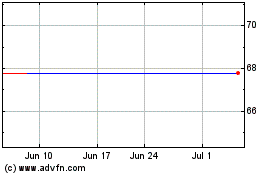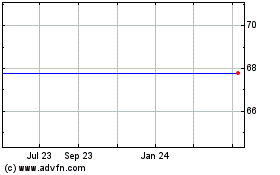SoftBank Bets on Internet of Things With ARM Deal
July 19 2016 - 1:09PM
Dow Jones News
By Stu Woo and Don Clark
CAMBRIDGE, England -- SoftBank Group Corp.'s $32 billion wager
on ARM Holdings PLC hinges on the British chip designer's promise
as a leader in the "internet of things," a nascent field connecting
everyday items like lightbulbs to the web.
So far, though, the market for such devices is small. Revenue
per sale is tiny. And it is unclear whether ARM can exploit the
industry in the same way it has dominated the global smartphone
business.
"It's not a given that everything else in the world is going to
run on ARM," said Rob Chandhok, a former Qualcomm Inc. executive
who specializes in the sector. "It's not a bad bet, but it's still
a bet."
Many SoftBank investors agree. Shares fell more than 10% in
Tokyo Tuesday, a day after SoftBank disclosed its deal to acquire
ARM.
ARM was founded in 1990 and is based in an office park in this
centuries-old university town. Far from a household name even in
the U.K., the company is a key player in the mobile-device industry
-- designing the basic architecture of about 95% of the world's
smartphones.
More recently, it has pushed to become a dominant designer of a
new breed of chips for the internet of things, or IoT, in industry
parlance. These chips are aimed at processing and wirelessly
transmitting data for a whole range of devices, including
smartphone-controlled thermostats, child-tracking bracelets and
web-connected refrigerators.
But markets for many such "smart home" devices are still niche,
with high price tags hampering wider adoption by consumers so far.
Wearable computing devices, another IoT focus, are still more
popular among technology enthusiasts than mainstream consumers.
Total industry revenue from IoT chips totals a few billion
dollars each year, estimates Malik Saadi, managing director at
research-firm ABI Research. That compares with the $80 billion
smartphone chip market.
While companies like Intel Corp. design and manufacture chips,
ARM is strictly a designer. It charges licensing fees and per-chip
royalties to other companies that use its schematics. Customers
like Apple Inc., Qualcomm and Samsung Electronics Co. began
flocking in the past decade to ARM-based chips because they drew
less power than rival chips from the likes of Intel, which made
high-performance but energy-guzzling processors.
Intel has closed the gap in energy efficiency, but it hasn't
countered the sheer volume of ARM licensees, all of whom compete on
price and new features. ARM says some of its processors have been
licensed by hundreds of companies. About 14.8 billion chips
containing ARM technology were shipped last year.
ARM has made some significant beachheads in new markets. It has
built a 90% share in total automotive "infotainment" processors,
for instance, Mr. Saadi at ABI Research said.
SoftBank is now betting that ARM-designed chips will take off
with these new markets. Andrew Frame, the company's director of
agriculture, said in a recent interview here that his current
project is trying to understand how farmers can use gadgets to
better monitor their soil and livestock.
"Everything will be connected," said SoftBank Chief Executive
Masayoshi Son, announcing the deal in London on Monday. "Cows would
be connected, chickens would be connected, the sheep would be
connected."
If a significant market does take root, ARM's other big
challenge is squeezing enough cash out of it. The company keeps
royalty rates low to court customers and spur demand.
"ARM likes to be in businesses where there are millions of
units," said Mr. Frame.
For the first quarter of 2016, the company reported $191.9
million in processor royalties from 4.1 billion shipments, an
average of 4.7 cents per chip. Analysts estimate a smartphone chip
in a high-end phone costs about $40 in components.
A tiny microprocessor in an internet-connected lightbulb could
cost just 50 cents, said Kris Flautner, head of ARM's IoT unit, in
a recent interview. That translates into ARM potentially earning
just fractions of a penny on each unit sold.
"The average selling price is going to be somewhat lower than
for mobile phones and computers," said Mr. Saadi.
Write to Stu Woo at Stu.Woo@wsj.com and Don Clark at
don.clark@wsj.com
(END) Dow Jones Newswires
July 19, 2016 12:54 ET (16:54 GMT)
Copyright (c) 2016 Dow Jones & Company, Inc.
Arm Holdings Plc ADS Each Representing 3 Ordinary Shares (MM) (NASDAQ:ARMH)
Historical Stock Chart
From Apr 2024 to May 2024

Arm Holdings Plc ADS Each Representing 3 Ordinary Shares (MM) (NASDAQ:ARMH)
Historical Stock Chart
From May 2023 to May 2024
